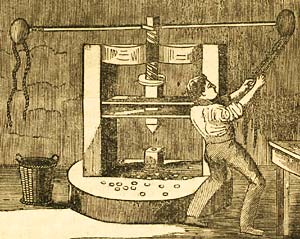Money

Engraving of a mint, from The Child's Arithmetic: A Manual
of Instruction for the Nursery and Infant Schools
(London: William S. Orr and Co., 1837)
Until 1971, British money was divided up into pounds, shillings and pence.
- One pound was divided into 20 shillings.
- One shilling was divided into 12 pennies.
- One penny was divided into two halfpennies, or four farthings.
There were therefore 240 pennies in a pound.
Common abbreviations
| Abbreviation |
Meaning |
| £ |
The sign for a pound was either the abbreviation 'li', or the £ sign. Both come from the Latin word 'libra', meaning 'pound'. The £ sign developed from a very elaborate capital 'L'. |
| s |
Shillings were usually abbreviated to 's'. The 's' stands for 'sesterius' or 'solidos', coins used by the Romans. |
| d |
Pennies were, confusingly, abbreviated to 'd'. This is because the Latin word for this coin was 'denarius'. |
| ob |
A still smaller Roman coin was an 'obulus'. The abbreviation 'ob' was used for halfpennies. |
| qua |
Farthings were abbreviated to 'qua', short for 'quandrans', or a quarter of a penny. The word 'farthing' is an old English word meaning 'a fourth-thing'. |
There were various ways in which monetary amounts were written out.
Amounts in full pounds, shillings and pence could be written in many different ways, and with or without the final 'd':
£1 9s 6d
£1.9.6
£1/9/6d
£1-9-6
Shillings and pence could be written as follows:
9s 6d
9/6 - spoken out loud as 'nine and six'
Shillings on their own could be written as follows. In the second example, the dash represents no pennies:
9s
9/-
Up to the seventeenth century, it was common for monetary amounts to be written out using lower case Roman numerals:
ixs vjd
Coins and units of money
| Coin |
Amount |
| ¼ d |
Farthing |
| ½ d |
Halfpenny, pronounced 'haypny'. The word often appears in print as 'ha'penny' |
| ¾ d |
Three farthings |
| 1d |
Penny |
| 2d |
Two pennies, or 'tuppence' |
| 3d |
Three pennies. The coin was sometimes referred to as a 'threepenny bit'. The word was often pronounced 'thrupny', or 'thruppence' |
| 4d |
Groat. This coin was in circulation until 1662, and was revived briefly in the mid-nineteenth century |
| 6d |
Sixpence, or 'tanner' |
| 1s |
Shilling, or 'bob' |
| 2s |
Two shillings, or 'florin' |
| 2s 6d |
Half a crown |
| 5s |
Crown |
| 10s |
Ten shillings, or 'half sovereign' |
| £1 |
One pound, or 'sovereign', commonly called a 'quid' |
| £1 1s |
One pound and one shilling (21 shillings), or 'guinea' |
A 'mark' was worth two-thirds of a pound, or 13s 4d. This was never a physical amount of money represented by a coin, but was a common amount used for accounting purposes.
Decimalisation
Britain changed its currency on 15th February 1971. The decimal system of currency divides one pound (£) into 100 pence (p). The old currency was therefore worth the following decimal amounts:
| Old currency |
Equivalent in decimal currency |
| 6d |
2½ p |
| 1s |
5p |
| 2s |
10p |
| 10s |
50p |
| £1 |
£1 |
For many years, some of the old pre-decimal coins continued to be used to represent their decimal equivalents. The sixpence piece - now worth 2½ p - was abolished in 1980. The shilling and two-shilling coins - used for 5p and 10p - were brought out of circulation in 1990 and 1992 respectively. For about ten years after decimalisation, the term 'New Pence' was used to distinguish newly-minted coins from the old pennies.
Next page: Glossary